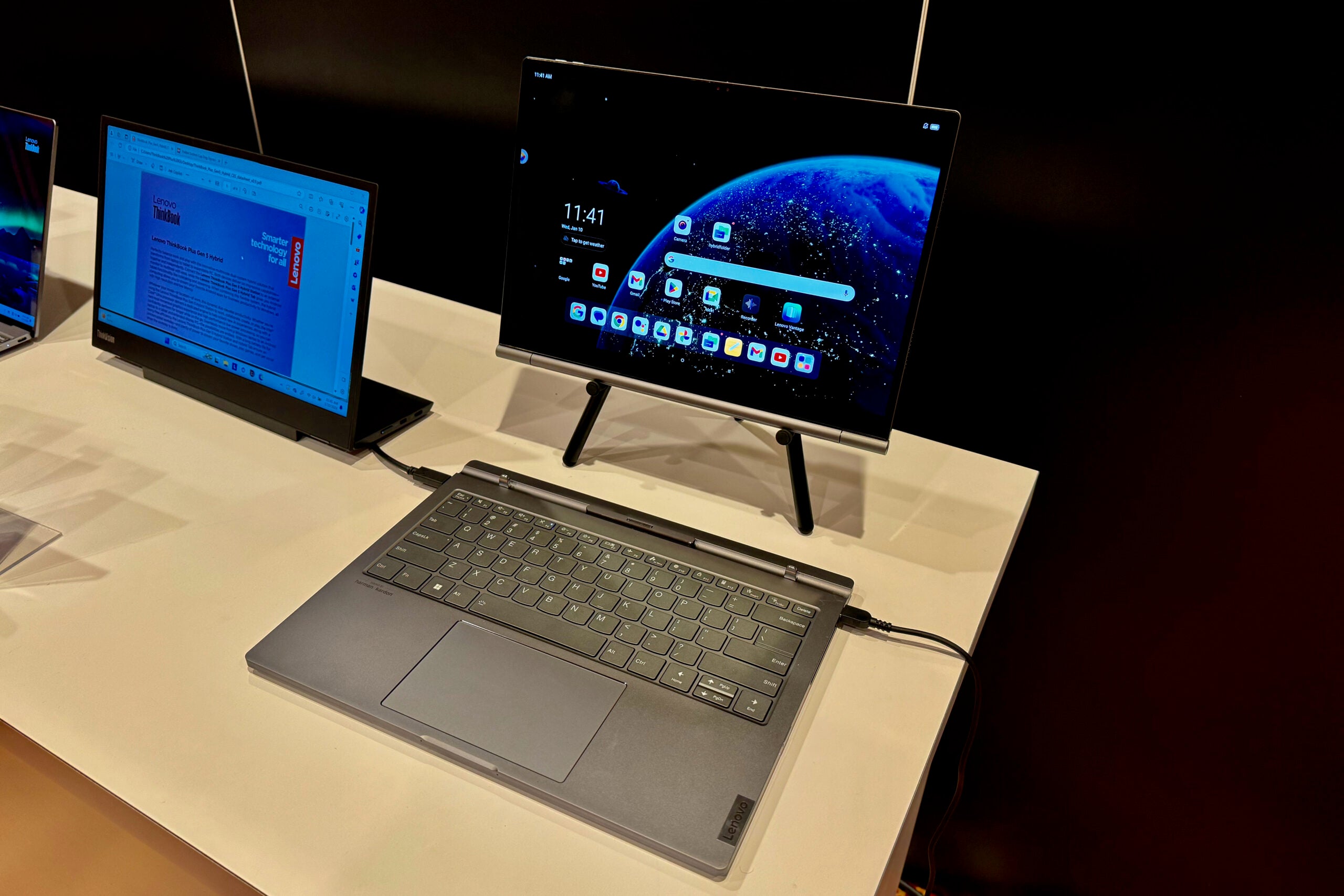Asus ROG Phone 8 Pro Edition Review
The latest gaming phone from Asus




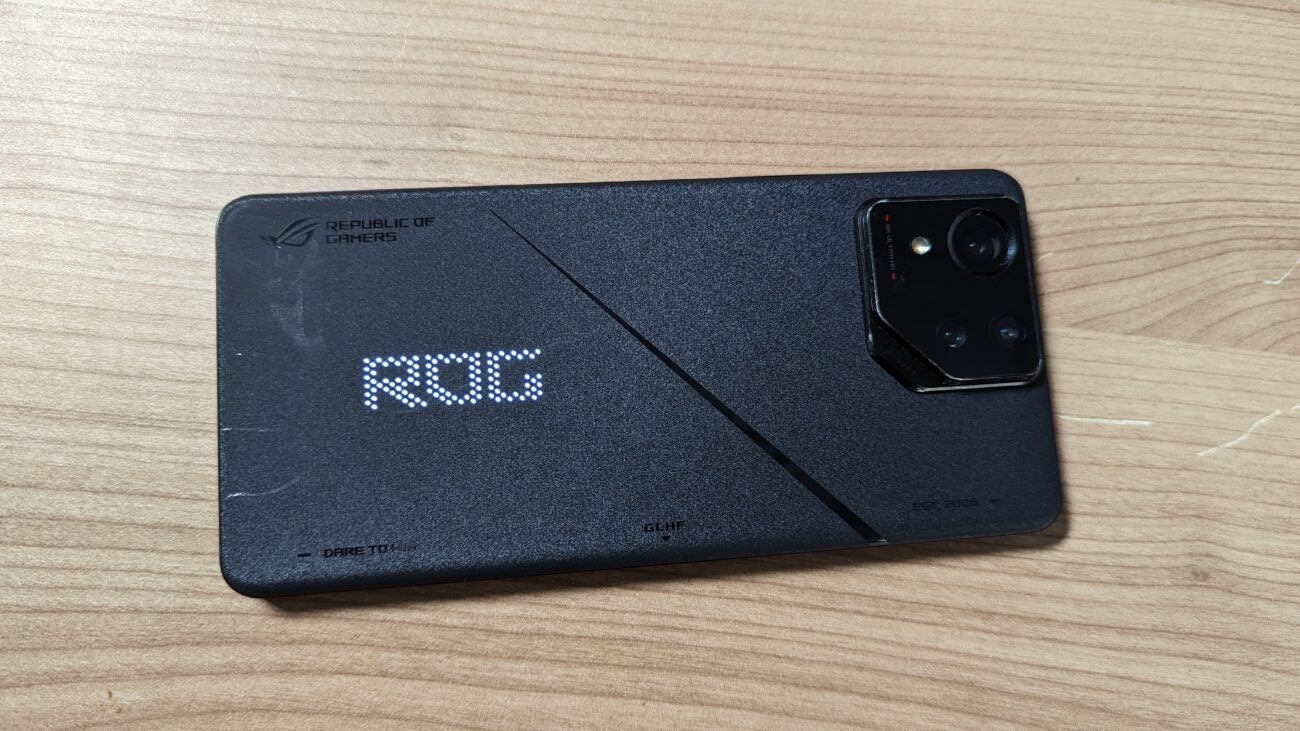

Verdict
The Asus ROG Phone 8 Pro Edition has toned down the flashy gaming design to appeal to a wider audience, consequently seeing compromises to the battery and speakers, but the 165Hz AMOLED screen, speedy performance and suite of gaming features nevertheless make this a good option for hardcore gamers.
Pros
- Blazing fast gaming performance
- Smaller design with improved waterproofing
- Camera has been upgraded with 3x optical zoom
- Still packed with excellent gaming features
Cons
- Rear gets scratched very easily
- Downgraded speakers
- Camera still not as good as the competition
Key Features
- Snapdragon 8 Gen 3 chipOne of the most powerful phones currently on the market.
- AniMe VisionPhone’s rear adorned with Mini LED lights to display notifications, the time and more.
- 32MP telephoto cameraThe new telephoto camera is capable of a 3x optical zoom.
Introduction
The Asus ROG Phone 8 Pro Edition is the latest gaming phone to enter the fray, flaunting a higher performance ceiling thanks to the new Snapdragon 8 Gen 3 chip.
However, the biggest change to the latest ROG Phone, compared to previous iterations, can actually be found with the design. Asus has decided to scale back the ‘in-your-face’ design of old to appeal to those beyond the hardcore gaming scene.
In order to compete with non-gaming flagships, Asus has also upgraded the camera with a 32MP telephoto sensor that makes a 3x optical zoom possible.
It makes sense for Asus to chase a wider market rather than ardently sticking to a niche, but is the Asus ROG Phone 8 Pro Edition in danger of alienating its loyal fans? Let’s dive in for a closer look.
Design
- More mature design aimed at a wider audience
- Smaller build, with shaven-down bezel
- AniMe Matrix lights add flair and personality
The Asus ROG Phone 8 Pro Edition has seen so many changes to its design that it is barely recognisable from its predecessors. The sci-fi emblazoned rear has been ditched in favour of a more low-profile look. This may disappoint gamers looking for something a tad flashier, but makes it more appealing to a wider audience.
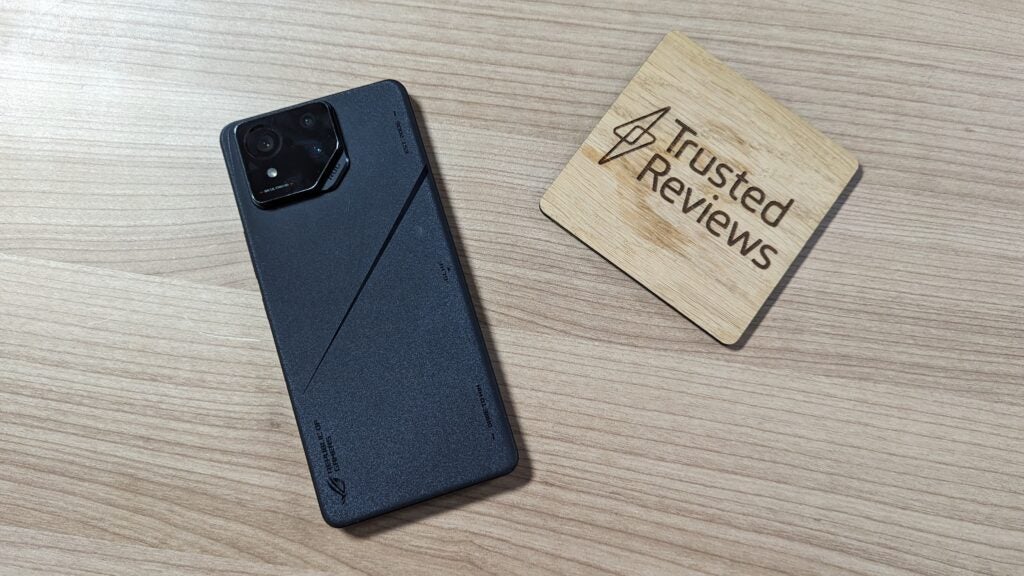
When using the Asus ROG Phone 8 Pro Edition out in public, I never had to worry about strangers giving me odd looks as I did the Asus ROG Phone 7 Ultimate – as much as I liked the design of the previous phone, it was a bit garish compared to the more mature offering I’m reviewing now.
That’s not to say the Asus ROG Phone 8 Pro Edition is completely void of gaming design quirks. I particularly like the AniMe Matrix feature, which uses Mini LED lights on the rear to display the likes of the time, battery status and notifications.

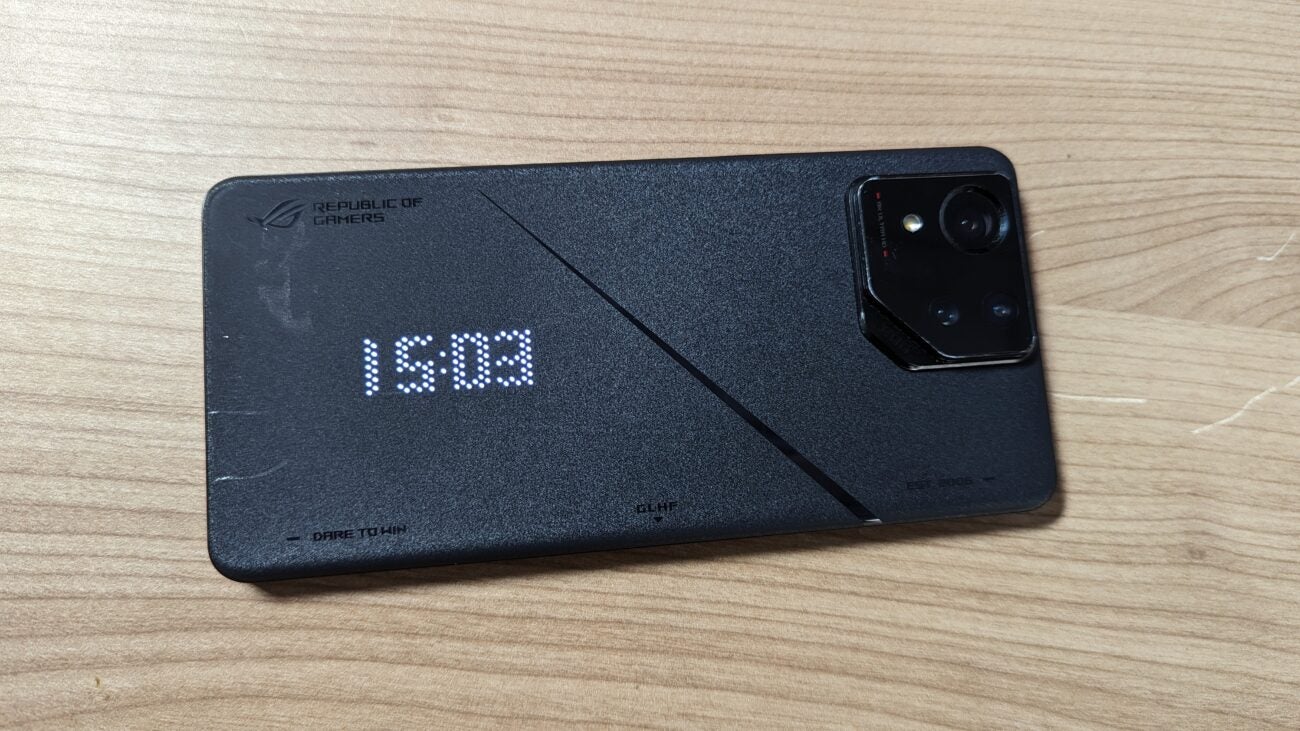
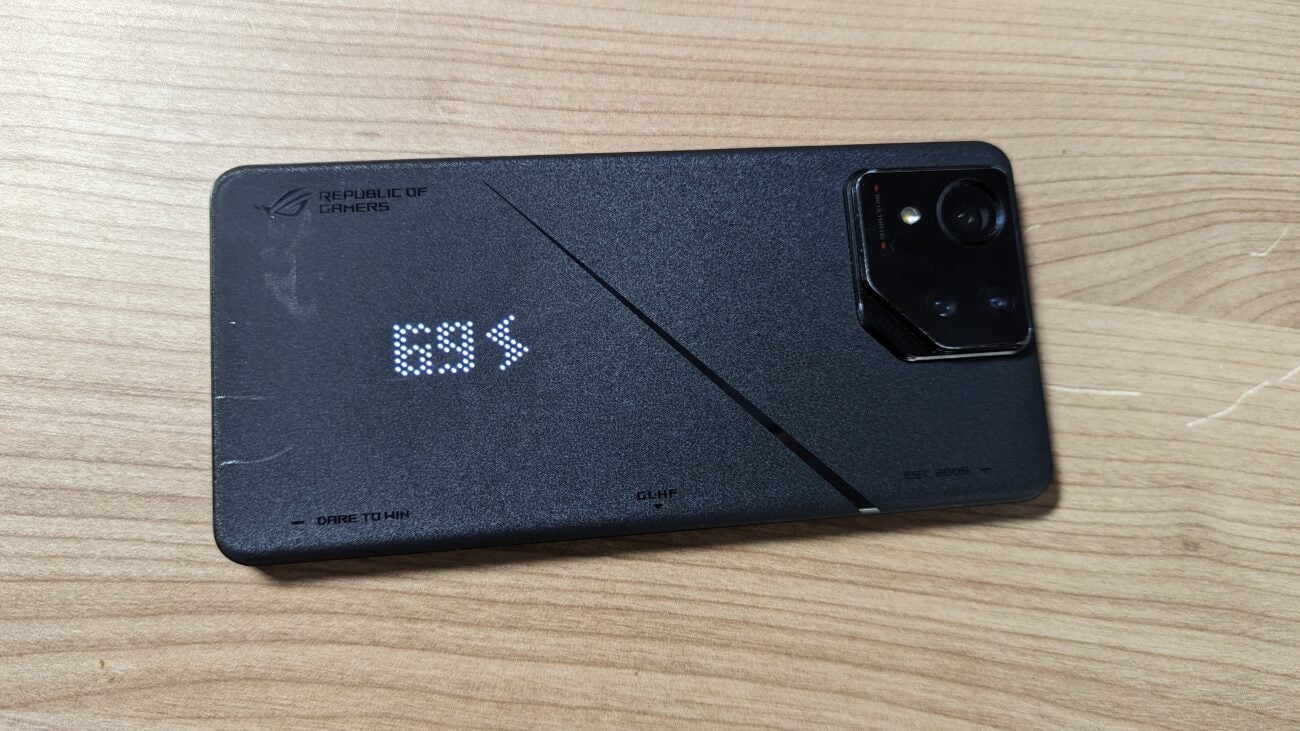
You can customise what the lights display, or even turn it off completely to conserve battery life. This AniMe Matrix feature is only available with the Asus ROG Phone 8 Pro and ROG Phone 8 Pro Edition – the standard ROG Phone 8 is limited to RGB lighting of the ROG logo instead.
However, I have one major bugbear with the phone’s rear; it is incredibly easy to scratch.
For the past few weeks, I’ve been keeping the ROG Phone 8 Pro Edition in my pocket along with my Google Pixel 6 and Sony WH-1000MX5 case. As a result, the ROG Phone is already covered in scratches and scuff marks. They are admittedly only visible when viewed from certain angles in bright light, but it’s still concerning for a phone that costs upwards of £1000/$1000.
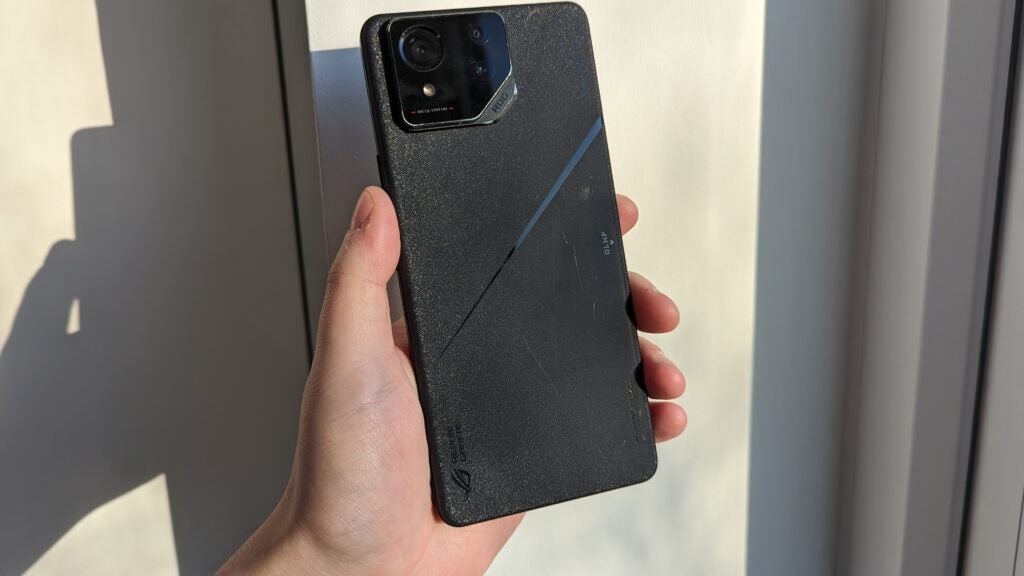
Most people admittedly won’t carry two phones around at once which may reduce the likelihood of scratches, but if my review sample is already scuffed after a couple of weeks, I imagine that any accidental bangs, scrapes and drops will result in a number of marks by the end of the year.
Using a case could solve this issue, but I’m not too fond of the look of the bundled Aero Case, while most other cases will block the AniMe Matrix feature.
Flip the phone over to its front, and you’ll notice that Asus has slimmed down the screen bezel for the Asus ROG Phone 8 series. This has allowed Asus to retain the same 6.78-inch screen size while also reducing the size of the phone. The Asus ROG Phone 8 is noticeably thinner than its predecessor making it significantly easier to hold, even with my small hands.
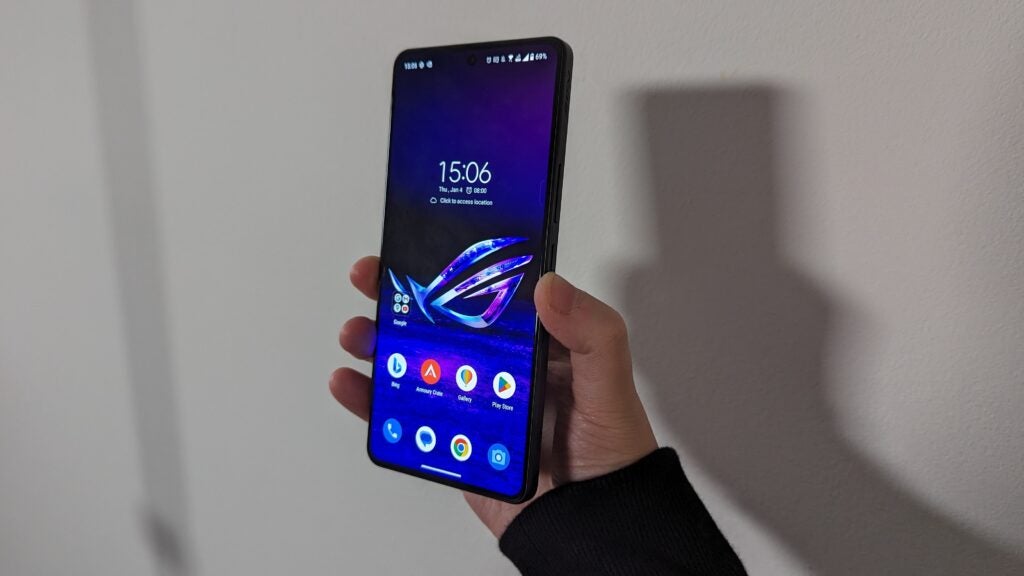
Asus has shaved the bezel away by placing the selfie camera under the screen, with a pinhole allowing it to peek through. This design choice has been adopted by the vast majority of Android phones, and helps to bring the ROG Phone 8 up to modern standards. Asus is also continuing with the fingerprint sensor embedded into the display, which works as well as you could hope for.
The downside of slimming those bezels is that there’s no longer room for the front-facing speakers. Instead, the speakers have been moved to the top and bottom edges of the phone, which is problematic since this is where my hands naturally rest when playing a game, resulting in muffled audio. There’s also no space for the amplifier this time, so there’s been a huge downgrade to the phone’s bass.
The AirTriggers were one of my favourite features of the ROG Phone 7, so I’m delighted to see their return. This enables you to use virtual triggers on the phone’s edge for the likes of shooting in Call of Duty. It’s fully customisable, even allowing you to set your preferred vibration intensity to ensure satisfying feedback.
Most people will probably prefer to use a controller accessory like the Backbone One or Razer Kishi instead, but the AirTriggers are an excellent substitute for when you don’t want to lug around an extra accessory.
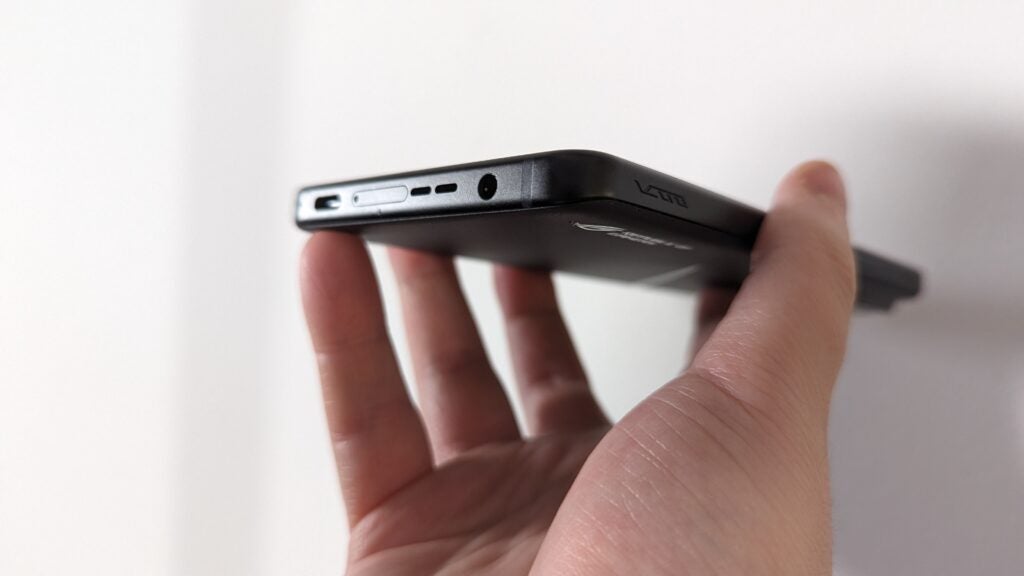
In terms of ports, you’ll find a pair of USB-C connections on the Asus ROG Phone 8 Pro Edition – one at the bottom in the conventional spot, and a second on the left side so you can carry on gaming without interruption, as well as plugging in the bundled AeroActive Cooler X. There’s also a headphone jack, which is unusual for a phone in 2024.
The Asus ROG Phone 8 Pro is bang up to date with wireless technology, supporting Wi-Fi 7 and Bluetooth 5.3. Asus has also made the phone more robust with an IP68 rating, bringing the waterproofing up to the same standard as the flagship Samsung and Google phones.
I can’t find any claims from Asus in terms of using sustainable materials for the ROG Phone 8 Pro Edition, which is disappointing. The phone comes in a stylish cardboard box which can be recycled, but many of the accessories within the box are wrapped in plastic.
Screen
- Same 6.78-inch screen size as before
- AMOLED display is even brighter now
- Still features up to a 165Hz refresh rate
The Asus ROG Phone 8 Pro Edition hasn’t seen sweeping changes to the screen compared to its older siblings. The AMOLED panel still comes in at 6.78 inches, while the Full HD+ resolution and 165Hz refresh rate remain unchanged.
However, Asus has managed to boost the peak brightness by a considerable margin, from 1600 nits to a whopping 2500 nits. This upgrade is obvious to the naked eye too, with the screen of my Google Pixel 6 looking dull by contrast.
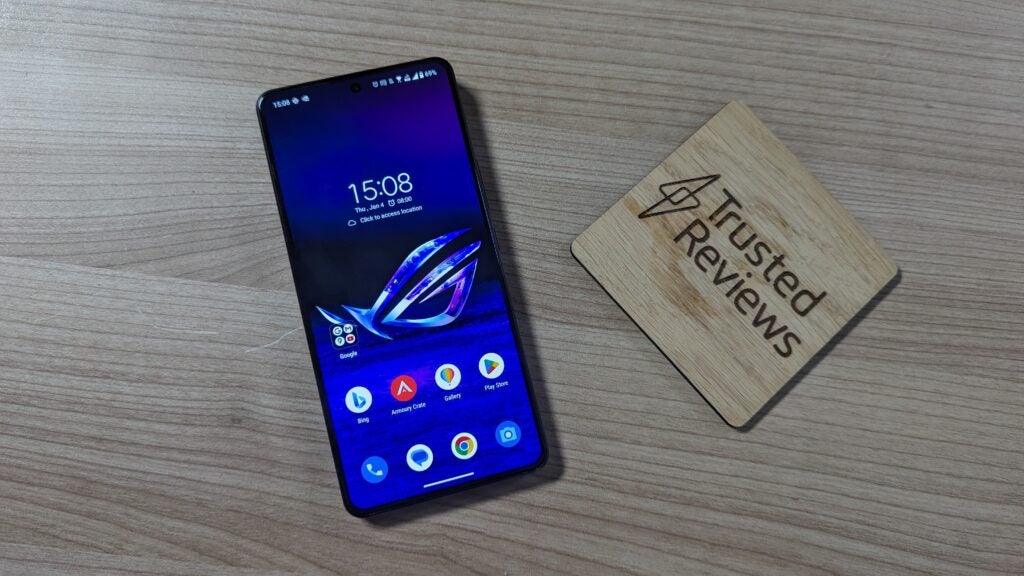
The higher brightness not only makes it far easier for me to view the display in bright conditions, but also results in more vivid on-screen colours when playing games and watching movies. It’s an absolute delight to ogle.
The AMOLED technology also ensures that the screen is capable of displaying inky blacks rather than murky greys, resulting in dazzling contrast. Other than upping the resolution – which would impact battery life and game frame rates – it’s hard to see how Asus can improve further on this fantastic smartphone display.
Camera
- New telephoto camera enables 3x optical zoom
- Gimbal helps to keep photos and videos more stable
- Selfie camera can now capture more people in frame
The Asus ROG Phone 8 family sports the same main 50MP sensor as before, but this time, it’s aided by a new gimbal that helps to achieve stable photos and videos.
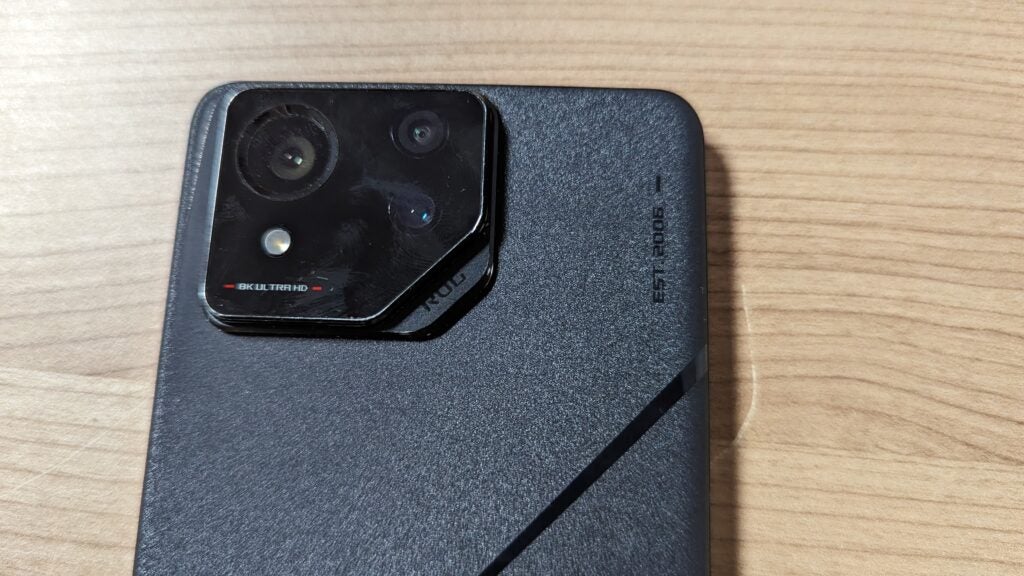
It’s a shame that there haven’t been any other meaningful upgrades to the main sensor, with the capture quality lagging far behind similar-priced phones from the likes of Apple, Google and Samsung.




During my time with the ROG Phone 8, I still found it to be a perfectly adequate snapper, producing bold colours and striking shots, but its limitations became clear in low-light conditions, struggling to even match my Google Pixel 6.
As you can see below the ROG Phone fell short when trying to capture image detail in the dark, with the buildings on the waterfront lacking definition and colours appearing washed out and muted.

The ultra-wide 13MP sensor also makes a comeback, although the 5MP macro snapper has been replaced with an all-new 32MP telephoto sensor. This is capable of a 3x optical zoom, enabling you to capture faraway objects clearly.
While this new telephoto sensor did make it easier for me to take a photo of distant subjects, I found the image quality would drop noticeably when using the 3x zoom. It’s certainly no match for the Galaxy S23 Ultra with its 3x and 10x lossless zooming.


You still get a 32MP selfie camera with the new Asus ROG Phone 8 series, but the field of view has been increased from 73 degrees to 90 degrees. This makes it easier to fit multiple people in the frame for a group selfie.
Performance
- One of the fastest chips you can buy
- Pro Edition features 24GB of RAM
- Available with up to 1TB of storage
The Asus ROG Phone 8 Pro Edition doesn’t disappoint in terms of performance, packing the all-new Snapdragon 8 Gen 3 chip, with frequency speeds peaking at 3.3GHz.
The Ultimate Edition also flaunts 24GB of RAM. I’d argue this is overkill for a gaming phone, with the standard ROG Phone 8 packing plentiful 12GB of RAM instead, although my review unit has posted the best gaming results we’ve seen from a phone yet.
The Asus ROG Phone 8 Pro Edition scored tremendous results of 106fps and 123fps in the GFXBench Aztec Ruins and GFXBench Car Chase benchmarks. Those are outstanding results, with the second-best performer being the Vivo X100 Pro at just 95fps and 105fps in the same tests.
With that said, the Vivo X100 Pro – powered by the new Dimensity 9300 chip – outperformed the ROG Phone 8 when it came to the CPU benchmarks. That shouldn’t be any cause for concern, with the Asus ROG Phone 8 Pro Edition still comfortably among the leaders in performance, especially in terms of graphics.
Asus hit a little snag in terms of heat dissipation for the Asus ROG Phone 8 Series, as heat convection is no longer an option with the jump up to IP68 waterproofing. However, the new inclusion of a rapid-cooling conductor still seems to be highly effective, with our 3DMark Extreme Stress Test showing the Asus ROG Phone 8 Pro Edition is able to maintain a stable high performance even at high workloads. I never noticed the phone becoming uncomfortably hot either.
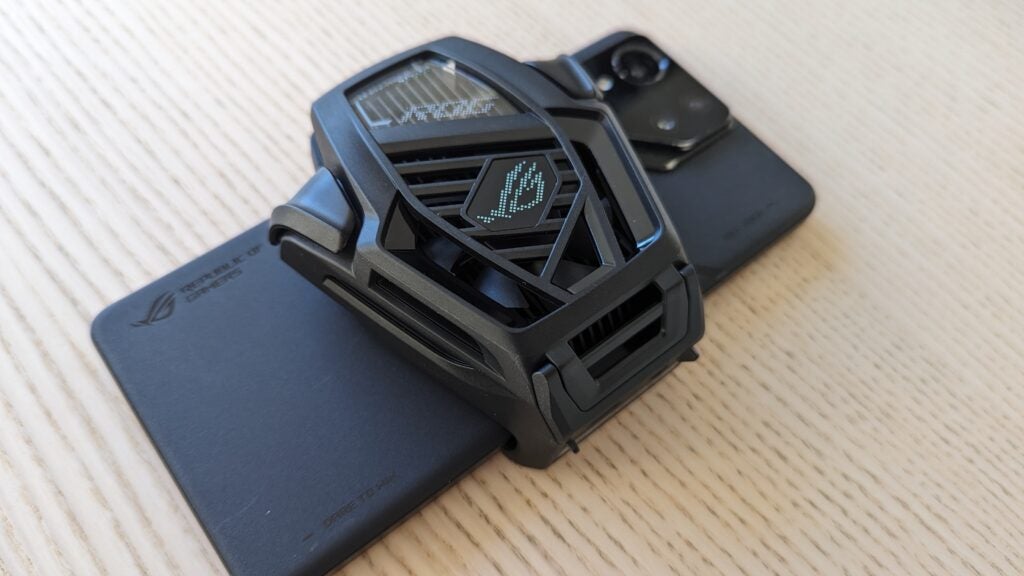
If you purchase the Pro Edition of the ROG Phone 8, you’ll get the AeroActive Cooler X bundled in. This clips onto the back of the phone, plugging into the horizontal USB-C port. I personally think this accessory is a little excessive, as the phone can remain cool after long sessions of games. It’s more about stabilising performance if you’re playing a game where high frame rates are vital.
You’re unlikely to run out of storage with the 1TB drive of the Pro Edition. If you’re planning on buying one of the cheaper models, then you’ll get 256GB with the standard ROG Phone 8, and 512GB with the ROG Phone 8 Pro.
Software
- Both stock and Asus-optimised Android available
- Game Genie offers lots of tweakable in-game settings
- A few AI features are made available
The Asus ROG Phone 8 Pro Edition is based on Android 14, and allows you to choose whether you’d prefer a stock Android experience, or one optimised by Asus. What’s more, Asus allows you to pick your preferred options for individual features, such as the clock appearance, incoming call display, quick settings panel and more. It’s great to see Asus giving you so much choice for your preferred experience.
The Armour Crate app also comes pre-installed on the phone, which lets you tweak performance settings, and set up the likes of AirTriggers, Key Mapping and Macros.
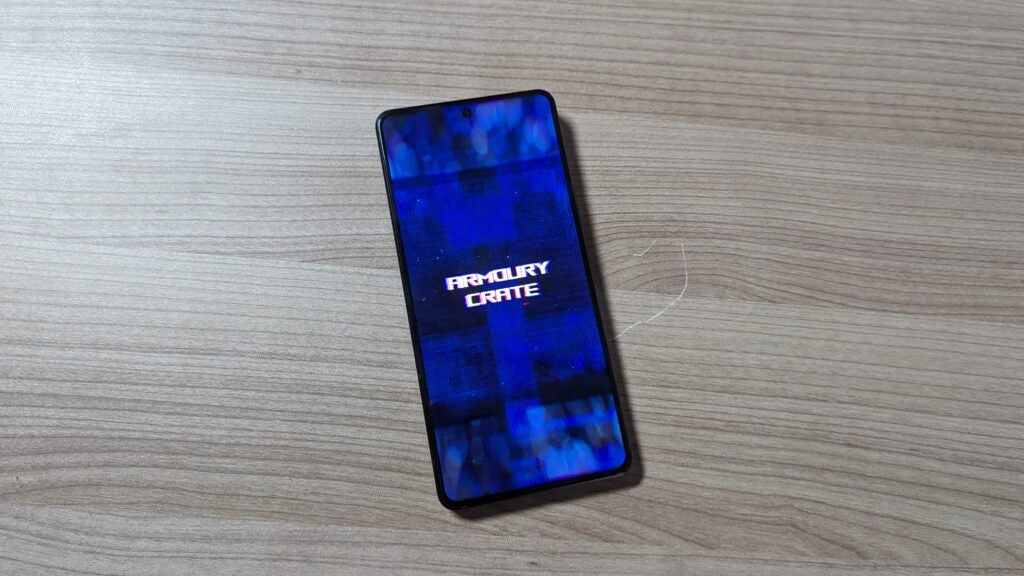
I’m especially fond of the Game Genie, which brings up a menu mid-game, allowing you to make tweaks on the fly. You can bring up real-time performance info, block incoming calls or start recording without digging around in your phone’s settings. It’s an impressive, streamlined solution that Asus has been refining for multiple years, and goes a long way to making this feel like a true gaming phone.
Asus has also gone big on artificial intelligence for the Asus ROG Phone 8 family. One of the most noteworthy features is the AI grabber, which makes it easier for you to Google helpful online guides when stuck mid-game, automatically detecting on-screen text which indicates which level or story mission you’re on.
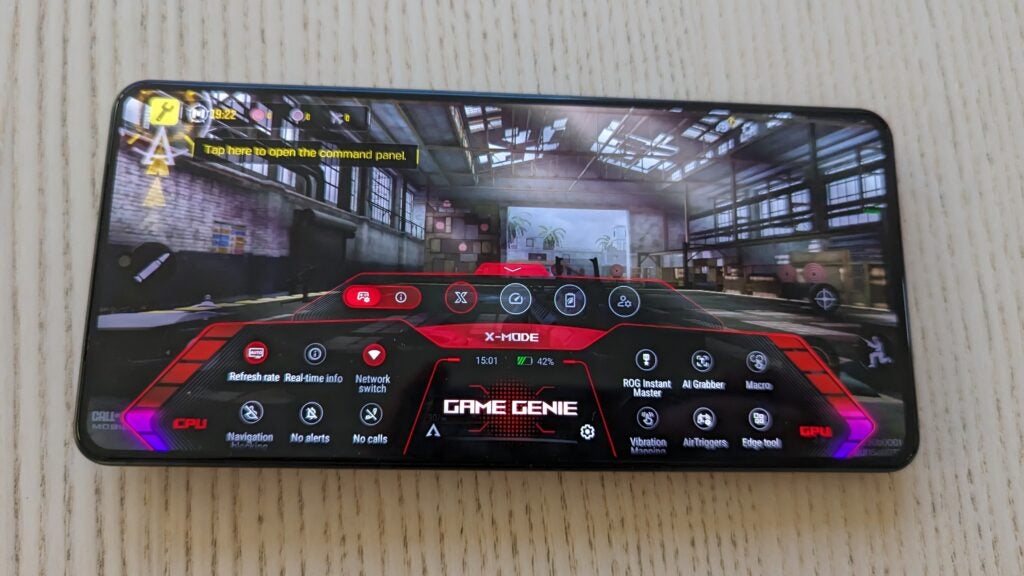
AI has also improved the phone’s search functionality when locating a specific app or setting. Plus, there’s the X Sense 2.0 feature, which can be used to automate item pickups and allow you to fast-forward through boring cutscenes – although these features are sadly limited to just Genshin Impact and Honkai: Star List for the time being.
Battery life
- Can easily last a full day with juice to spare
- Playing games takes up around 9% per 30 minutes
- Can fully recharge in 45 minutes
Asus has been forced to compromise battery capacity when slimming down the design of the Asus ROG Phone 8 Pro Edition. While the Asus ROG Phone 7 family had a 6000mAh cell, the ROG Phone 8 series has been downgraded to a 5500mAh capacity.
I don’t think this is a cause for concern though. The improved efficiency of the Snapdragon chip maximises the phone’s stamina despite the smaller capacity. As a result, it easily lasted beyond a full day for general use, with between 30% and 40% usually left in the tank. I never had any fears that it would run out of juice before the end of the day.
You should really only notice the drop in battery longevity when playing games. After playing 30 minutes of Call of Duty Mobile, the battery had depleted by 9%. If the battery continued to drain at a steady rate, this suggests you’d be able to keep playing for five and a half hours before you hit 0% on the battery.
The ROG Phone 8 comes bundled with a 65-watt charger capable of incredibly fast charging speeds. In my tests, it took just 45 minutes to fully recharge the phone from 0% to 100%, and if you’ve only got time for a quick 15-minute recharge, that will still give you an impressive 46% top-up.
Latest deals
Should you buy it?
You want fast performance and great gaming features
The Asus ROG Phone 8 Pro Edition is one of the fastest smartphones we’ve ever tested, while features like AirTriggers make it a lot easier to play games without an accessory.
You want a solid all-round smartphone
Asus still hasn’t quite succeeded in offering an all-round phone that can compete with the likes of Apple, Google and Samsung, with a sub-par camera and a scratchable casing.
Final Thoughts
The Asus ROG Phone 8 Pro Edition is an intriguing departure for the series, with Asus toning down the design to make it more appealing to a broader audience. I do like the subtler styling and smaller design, but the downgrade to the speakers is disappointing, and the scratchable casing is a big concern for a phone at this price.
However, this phone excels where it matters most, with a super-speedy performance, lengthy battery life and a litany of features that make gaming on the go a blast. More work is needed for the camera to compete with the likes of Google and Samsung, but the new telephoto lens is still a welcome addition.
If you’re happy to forgo the gaming software, I do still think you’ll get a better all-round package from the likes of the Samsung Galaxy S23 Ultra, and if you’d prefer a phone that fully embraces its gaming identity, then it’s worth considering the RedMagic 9 Pro. Check our Best Gaming Phone list for even more options.
How we test
We test every mobile phone we review thoroughly. We use industry-standard tests to compare features properly and we use the phone as our main device over the review period. We’ll always tell you what we find and we never, ever, accept money to review a product.
Find out more about how we test in our ethics policy.
Used as a main phone for over a week
Thorough camera testing in a variety of conditions
Tested and benchmarked using respected industry tests and real-world data
FAQs
The ROG Phone 8 is powered by the Snapdragon 8 Gen 3 processor.
Yes, this phone has been designed for gaming with a powerful performance and oodles of gaming features.
Yes, the ROG Phone 8 has an IP68 rating.



